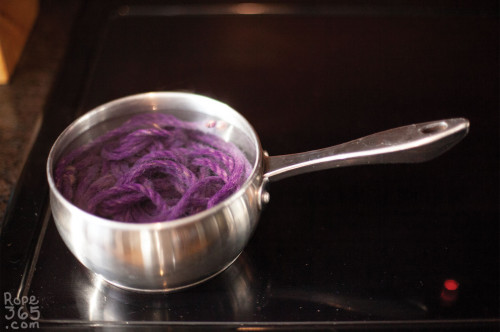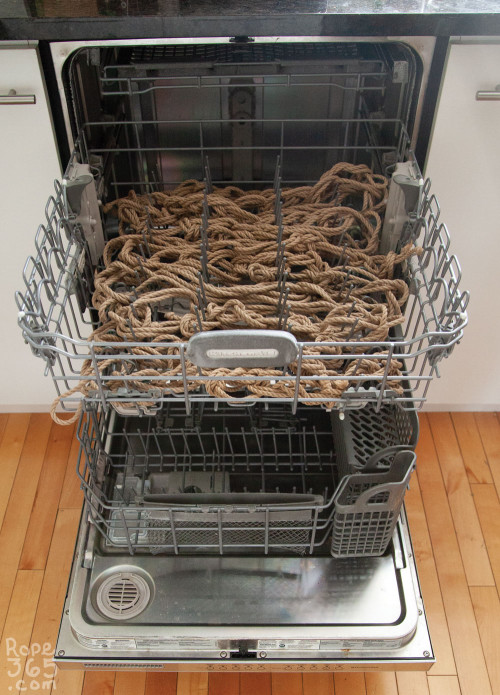Day 47: Conditioning
When you start a brand new set of rope, it will generally be stiff, and hard to tie with. As the rope keeps getting used, it will soften over time and become softer and softer. To help prepare your rope for its first adventure, you might want to process it to make sure it is clean and soft enough.
Should I Condition my Rope?
The decision to condition a rope or not is a personal choice, it also depends on the type of rope you are using. Many people opt to get the conditioning done by a rope maker as this is a time-consuming process, others will prefer to do it themselves as a bonding experience with their rope, or to save the money. Even if you get the conditioning done by someone else it is interesting to understand the different techniques to make sure you request the preparation that fits your needs.
If you are using synthetics, chances are your ropes can be used as it. You might still want to process it to make it softer and make sure it is clean before its first use.
Natural fibre will need a minimum of conditioning. Stiff rope with a tight twist will require more work. Cotton ropes may be ready to use after a simple cleaning, but hemp or jute are likely to be stiff, hairy, scratchy, and contain some nasty chemicals. The conditioning process should help it make a clean, smooth and flexible rope.
In particular, getting rid of chemicals in the rope can be an important part of the processing to make it safe for use. Rope marked as “food graded” is safe and ready to do. Jute is often spun using JBO or jute batching oil. It is common for people to have allergic reactions to it, the petroleum smell can be unpleasant, and the risks of long term exposures are unknown. Removing the JBO will also weaken the rope integrity. Some parts of the process will help remove some of it but one can never be truly sure it is completely gone. If you are concerned with the presence of JBO in your rope but you still want to use jute, invest in rope spun without JBO.
Some prefer to use their rope raw or very close to it, and let the process of tying make the rope softer, others will prefer to have their rope perfect from the get-go. Everything is a compromise as the process of conditioning rope does weaken it and will shorten its lifespan.
Rope Conditioning Techniques
Different techniques will affect the rope in different ways, they can be combined to make the perfect recipe. For synthetic ropes, a simple cleaning is recommended.
Breaking/polishing rope
Goal: Break the hardest fibres to make the rope supple and flexible. Also affects the twist of the rope and can make the rope weaker.
Breaking the rope makes a lot of dust, make sure to do this outside or in a well-ventilated area. Masks, glasses and/or gloves are also recommended.
- Hang a carabiner (nice round bottom, not sharp otherwise it damages the rope)
- Pass one end of the rope in the carabiner and wrap it around itself. Some do 3 or 4 twists, or make a Munter hitch.
- Make a seesaw movement a few times. Then progressively apply this process on the entire rope. More movements mean more supple rope but also weaker rope, find the right balance for your needs.
The alternative is to put the rope in the tumble dryer so the movement will break the rope, this allows you to add heat (see baking) but will create a lot of dust inside your drying machine.
Singeing
Goal: removing the fuzzies, making the rope more smooth. This will likely burn off some of the chemicals in the rope if there are any, but not all of it. Do not singe synthetic rope as it will melt.
For singeing you will need a flame, a gas stove works great, or a kitchen torch will do the job. Flames like candles will work but will also put a lot of soot on the rope. Run the rope in the flame without stopping (otherwise, it may damage the rope), repeat until all the fuzzies are gone. Once you are done, remove the soot from the rope by running a dry or damp cloth along the rope.
Wet treatment
Goal: clean the rope and make them more flexible. This will generally remove some of the chemicals in the rope if there are any, but not all of it. Some types of rope are sensitive to water and will become weaker when wet.
There are a couple of methods to do a wet treatment on the ropes. You can decide to add soap or not.
- Boiling: Put in a pot, cover with water, bring to boiling temperature.
- Washing machine: put in a laundry bag or coil in a chain sinnet (Day 188) to prevent tangling.
- Dishwasher: Keeps the rope well in place. Deactivate the heating cycle if you don’t want to add heating treatment
Drying your rope improperly afterward can make it full of kinks. Most rope can be hung up to dry, but the best is to dry it under tension. This process is critical for Jute to maintain its integrity, otherwise it will shrink and deform. To dry rope under tension, you can use two points and pull the ropes between the two. You will have to retension the rope as it dries to keep it straight. An alternate method is to hang it in a pulley with a weight on it so that the weight maintains the tension as it dries off. If you fail the drying process and end up with ropes full of kinks, you can always try to make it wet again and improve your drying process.
Baking
Goal: kill germs and remove chemicals off the rope. This process makes the rope weaker because it may remove oil that may be essential to its structure and getting the rope dry makes it more brittle.
Baking the rope at low temperatures will make oil in the rope evaporate which is great if you want to get rid of it. You will need to keep good ventilation as the chemicals evaporate so that they actually leave the rope. The vapours from baking JBO are likely to be toxic, so proceed with caution. Even if it is not clear if the JBO can be completely removed with baking, people who are allergic seem to do much better after this process.
Waxing & Oiling
Goal: keep the rope smooth and healthy. Dry rope will quickly become more fragile.
Oil is an important process for natural rope, it should be done regularly. Some oil will go rancid or cause allergies, make sure you pick wisely. Mineral oil is the safest bet as it is cheap, easy to acquire and hypoallergenic. You can also try other types like jojoba that will be slightly more expensive. To put oil on your rope, you can just put some in your hand, or soak a small cloth and run the oil over the rope on its whole length.
Adding wax is another option, some like how slick it makes the rope, some will hate the texture of it. To apply wax, mix it with oil into a small cake, and then rub the cake along the rope. It is best to oil the rope before adding the wax as the wax may seal the rope and you want to keep the core from getting dry. It is recommended to bake the rope after applying the wax so the wax sinks into the rope.
Sun and Freezing
Goal: Kill germs on the rope.
A more unusual cleaning technique is to expose the rope to the sun and put it in the freezer. This will kill a wide range of germs but not all of them. Note that the sun can dry out the rope, make sure it is well oiled not to weaken it. Some will prefer this to wet treatment as it can be less damaging to the rope. Unlike wet treatment, this will not clean the rope from dirt and soot.
Practice Time!
Create your own recipe! Try treating ropes with different techniques and observe how it changes the rope. Different ropes will react differently when processed depending on the material and construction. If you have several identical ropes, keep one untreated to see the difference. Take some time with your ropes and make them pristine.
Exploration ideas
- Observe the impact of the polishing technique, do 1 pass on a rope, 2 passes on another, etc. How much impact does polishing have on your rope? Is there a point where the difference is not noticeable anymore?
- Boil different ropes for different amounts of time, is there a noticeable difference once the rope is dried?
- Baking different ropes for a different amount of time. How does this affect the rope dryness and smell? Does it impact other rope characteristics?
- Try different amounts of singing, how much can you burn it until it affects the core of the rope?
- How does the order of the different techniques interact with each other? For example, if you singe before breaking the rope, does it create less dust, or do you need to singe again afterward?
- Apply different kinds of oil/wax, what are the differences?
Try preparing different types of ropes and look a the differences
Inspirations and Resources
- “How do I clean rope” and other musings by Treezy
- Conditioning Jute Rope, video series by MrLuckiesRope
- Conditioning Rope, from the start to the bitter end by MrLuckiesRope
- Conditioning Jute Rope, video series by M0co
- WykD Dave M0co Rope Treatment, video by WykD Dave
- Rope Maintenance, video by BelleCorde
- Drying under tension with weights, picture by nennemich
- Rope Processing Revised by -EM-
- About rope conditioning by akuaku
- Prepping hemp and jute….. how I does it. by Jahc
- How I Treat my Ropes? by Wintermute
- How to bake your jute and get rid of that JBO smell. By Action_Bastard
- Oil, wax & conditioning advice by Amatsunawa’s
- Notes for class: Hygiene for BDSM by Neuromancer28
- Before and after dry cleaning, picture by UmeRadio
- Rope tidbits – about Jute Batching Oils by MoonlightShadow
- Rope Tidbits – more on debunking JBO myths by MoonlightShadow
Credit: R/P: Ebi McKnotty
Or return to The Rope for more options.



2023-01-14 at 7:44 PM
When I was a tree trimmer in the 60s, we would wrap our new three twist 150ft
hemp rope around a tree a.few times hold tag end and pull with truck